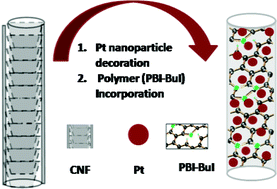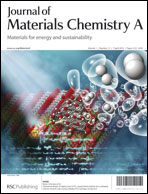A novel electrocatalyst system with unique multifunctional characteristics, originated by the presence of a proton conducting polybenzimidazole (PBI-BuI) bound layer and electron conducting hollow carbon nanofibers (CNF) with catalytically active Pt nanoparticles, has been devised based on a simple strategy. This was achieved by decorating Pt nanoparticles along the inner cavity, as well as on the outer walls of the hollow CNF support (F-Pt). In a further extension, a low molecular weight PBI, synthesized by optimizing the experimental parameters, was incorporated into the inner cavity and along the outer surfaces of F-Pt. Excellent dispersion of the Pt nanoparticles was achieved by properly utilizing the available carbon surface results in improved electrocatalytic activity, while the CNF backbone ensures high electron conductivity as well. The polymer binder coverage formed along the inner and outer wall surfaces provides an efficient triple phase boundary (TPB) around the Pt nanoparticles to facilitate the electrode reactions. The amount and the viscosity of the PBI-BuI in the electrode material were systematically varied to study the influence on the electrochemical performance. Transmission electron microscopy analysis confirms PBI insertion into the tubular cavity of CNF. Pore size distribution analysis implies that both the viscosity and the amount of PBI-BuI have a pivotal role in defining the microstructure of the electrode. Electrochemical studies using cyclic voltammetry (CV) and rotating disc electrode (RDE) reveal the exceptionally high activity of this hybrid material with an improved electrochemically active area. The significant improvement for the oxygen reduction reaction is further confirmed by the single cell analysis also. The high power density displayed by the PBI-BuI based system, as compared to the Nafion based system, validates the conceptualization of the well controlled triple-phase boundary in the system. These results demonstrate that PBI-BuI has a constructive effect in tuning the electrochemical activity at an optimum amount and at a favourable viscosity of the proton conducting polymer.

You have access to this article
 Please wait while we load your content...
Something went wrong. Try again?
Please wait while we load your content...
Something went wrong. Try again?


 Please wait while we load your content...
Please wait while we load your content...